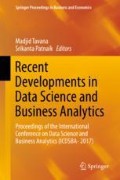Abstract
This paper proposed and developed a set of fuzzy time series prediction model FTSFM (Fuzzy Time Series Forecasting Model) based on the historical data, the concepts of fuzzy number function and inverse fuzzy number function and predictive function, which the basic theory of FTSFM was initially established. The general elements of FTSFM and the prediction function are FTSFM (μ). FTSFM (0.0004) is one of the commonly used prediction models of FTSFM. Based on the forecast of tourism revenue of Sanya city in 2006~2014, this paper introduces the whole process of the application of FTSFM (0.0004). FTSFM (0.0004) provides a new way of thinking for the research of time series prediction.
Access this chapter
Tax calculation will be finalised at checkout
Purchases are for personal use only
References
Zadeh, L. A. (1965). Fuzzy set. Fuzzy Sets and Systems, 8, 338–353.
Song, Q., & Chissom, B. S. (1993). Forecasting enrollments with fuzzy time series – Part I. Fuzzy Sets and Systems, 54, 1–9.
Song, Q., & Chissom, B. S. (1994). Forecasting enrollments with fuzzy time series – Part II. Fuzzy Sets and Systems, 62, 1–8.
Saxena, P., Sharma, K., & Easo, S. (2012). Forecasting enrollments based on fuzzy time series with higher forecast accuracy rate. Computer Technology & Applications, 3, 957–961.
Hagawati, B., Joshi, P., & Kumar, S. (2013). A computational method for fuzzy time series forecasting based on difference parameters. International Journal of Modeling, Simulation, and Scientific Computing, 4, 1–12.
Uslu, V. R., Bas, E., Yolcu, U., & Egrioglu, E. (2014). A fuzzy time series approach based on weights determined by the number of recurrences of fuzzy relations. Swarm and Evolutionary Computation, 15, 19–26.
Kai, C., Ping, F. F., & Gang, C. W. (2010). A novel forecasting model of fuzzy time series based on K-means clustering. IWETCS, IEEE, pp. 223–225.
Wang, H. X., Guo, J. C., Feng, H., & Zhang, F. J. (2014). A new model of forecast enrollment using fuzzy time series. International Conference on Education Management and Management Science (ICEMMS 2014) (pp. 95–98) August 7–8, Tianjin, China.
Gao, Y., & Liu, Y. J. (2016). Adaptive fuzzy optimal control using direct heuristic dynamic programming for chaotic discrete-time system. Journal of Vibration and Control, 22, 595–603.
Cheng, C. H., Chen, T. L., Teoh, H. J., & Chiang, C. H. (2008). Fuzzy time series based on adaptive expectation model for TAIEX forecasting. Expert Systems, 34, 1126–1132.
Jilani, T. A., & Burney, S. M. A. (2007). M-factor high order fuzzy time series forecasting for road accident data. IEEE-IFSA 2007, June 18–21 Cancun, Mexico.
Liu, Y. J., Gao, Y., Tong, S. C., & Li, Y. M. (2016). Fuzzy approximation-based adaptive backstepping optimal control for a class of nonlinear discrete-time systems with dead-zone. IEEE Transactions on Fuzzy Systems, 24, 16–28.
Chen, S. M. (2002). Forecasting enrollments based on high-order fuzzy time series. Journal of Cybernetics and Systems, 33, 1–16.
Duan, M., Shi, J., Wang, J. H., & Lu, X. L. (2003). Control system based on fuzzy-neural network theory for an engine test bed. Journal of Jilin University of Technology(Natural Science Edition), 33, 107–109.
Shi, J., Duan, M., Chen, Y., Zhang, T., & Lu, X. L. (2006). A research on fuzzy neural network control for the measuring system of engine test bed. Journal of Automotive Engineering, 28, 1000–680x.
Liu, Y. J., Tong, S. C., Li, D. J., & Gao, Y. (2015). Fuzzy adaptive control with state observer for a class of nonlinear discrete-time systems with input constrain. IEEE Transactions on Fuzzy Systems, https://doi.org/10.1109/TFUZZ.2505088, (in press).
Jilani, T. A., Burney, S. M. A., & Ardil, C. (2007). Multivariate high order fuzzy time series forecasting for car road accidents. International Journal of Computational Intelligence, 4, 15–20.
Liu, Y. J., & Tong, S. C. (2015). Adaptive fuzzy control for a class of unknown nonlinear dynamical systems. Fuzzy Sets and Systems, 263, 49–70.
Acknowledgments
This work is supported by Natural Science Foundation of Hainan Province (Grant No.714283), Scientific Research Foundation of Qiong zhou University (Grant No.QYXB201301).
Author information
Authors and Affiliations
Editor information
Editors and Affiliations
Rights and permissions
Copyright information
© 2018 Springer International Publishing AG, part of Springer Nature
About this paper
Cite this paper
Lu, X.L., Wang, H.X., Zhao, Z.X. (2018). Fuzzy Control and Network System Design for Time Series Prediction Model. In: Tavana, M., Patnaik, S. (eds) Recent Developments in Data Science and Business Analytics. Springer Proceedings in Business and Economics. Springer, Cham. https://doi.org/10.1007/978-3-319-72745-5_36
Download citation
DOI: https://doi.org/10.1007/978-3-319-72745-5_36
Published:
Publisher Name: Springer, Cham
Print ISBN: 978-3-319-72744-8
Online ISBN: 978-3-319-72745-5
eBook Packages: Business and ManagementBusiness and Management (R0)

